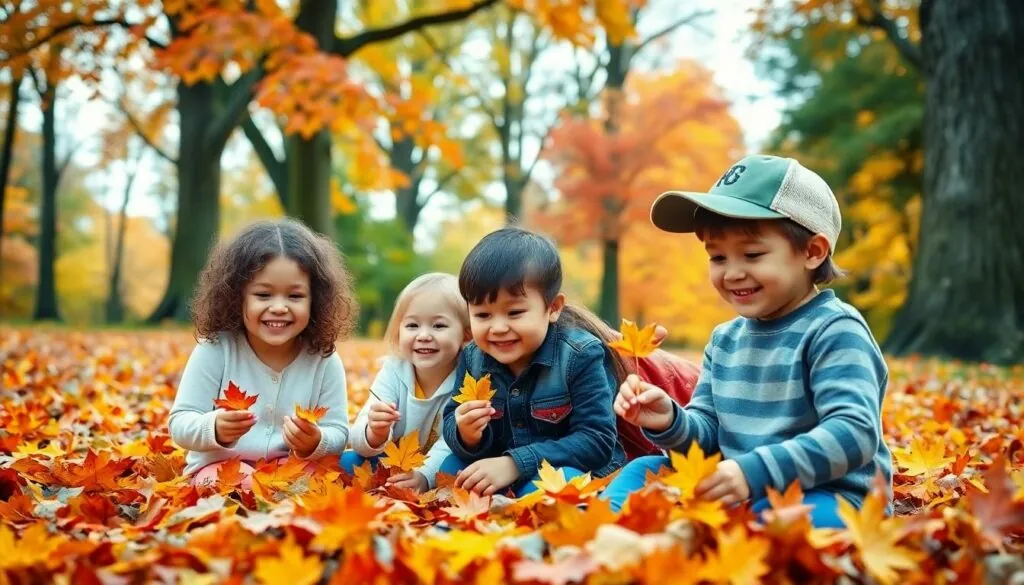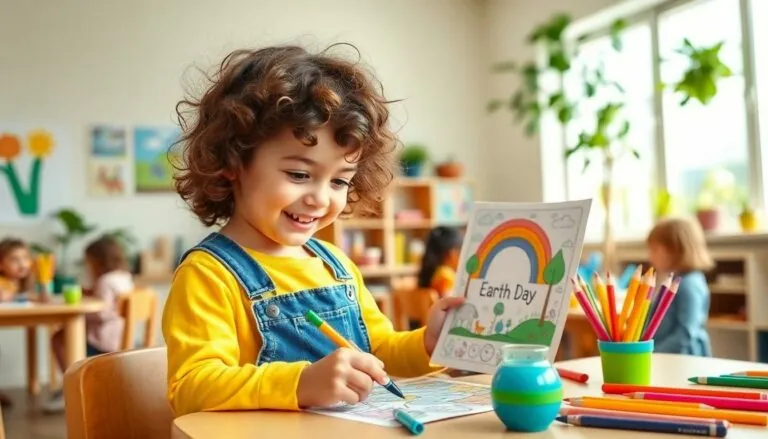Table of Contents
ToggleAs autumn paints the world in vibrant hues, preschoolers everywhere are itching to dive into the great outdoors. What better way to harness that energy than with fun leaf activities? These colorful treasures offer endless opportunities for creativity, learning, and a sprinkle of giggles.
Imagine the joy on their faces as they transform ordinary leaves into extraordinary art, or embark on a nature scavenger hunt that turns the backyard into a mini adventure park. Not only do these activities spark imagination, but they also sneak in a little science and fine motor skills practice. So grab those leaves and get ready for a season filled with laughter and learning—because who knew leaf play could be so leaf-tastic?
Overview of Leaf Activities for Preschoolers
Engaging preschoolers in leaf activities enhances their sensory experiences and nurtures their curiosity about nature. Numerous exciting activities incorporate leaves, each targeting different developmental skills.
Creating leaf rubbings offers a tactile experience that allows children to explore textures and patterns. By placing a leaf under paper and rubbing a crayon over it, kids discover unique leaf shapes while honing fine motor skills. Collecting leaves during nature walks serves as a scavenger hunt that promotes physical activity and observation skills.
Crafting with leaves provides an artistic outlet. Activities such as leaf printing let children experiment with colors and shapes, fostering creativity. Incorporating leaves into storytelling activities ignites imagination, as children can create stories based on their findings.
Sorting leaves by color and size introduces foundational math concepts. They can categorize leaves into groups, enhancing their observational skills and understanding of classification.
Engaging in science experiments, such as observing how leaves change color, invites preschoolers to explore the environment. These activities not only provide entertainment but also support science education.
Leaf activities can also be seasonal, aligning with changing colors in autumn. For example, creating leaf wreaths can involve various leaves collected throughout the season.
These engaging activities foster social interaction when done in groups. Children learn to share, collaborate, and communicate their thoughts while engaged in creative play. Opportunities for laughter and learning abound with these diverse leaf activities, making the most of the autumn season.
Benefits of Leaf Activities
Leaf activities offer numerous benefits for preschoolers. Engaging with leaves promotes physical, cognitive, and social development in a fun and interactive way.
Enhancing Motor Skills
Activities like leaf rubbings and crafting with leaves strengthen fine motor skills. Preschoolers grasp, pinch, and manipulate leaves, boosting hand-eye coordination. Collecting leaves during nature walks encourages gross motor movement, enhancing balance and physical coordination. Using scissors to cut leaves for projects further develops dexterity. Engaging in these activities provides essential practice for everyday tasks, laying a foundation for future learning.
Fostering Creativity
Leaf activities ignite imagination and creativity in young minds. Creating leaf art encourages self-expression as preschoolers explore colors and designs. Crafting with leaves invites them to think outside the box, transforming a simple leaf into a unique masterpiece. Storytelling with leaf collections stimulates narrative skills, enabling children to weave fascinating tales. Exploring different art techniques, such as leaf printing, enhances artistic skills and fosters an appreciation for nature’s beauty.
Types of Leaf Activities
Exploring different types of leaf activities engages preschoolers’ curiosity and creativity. These activities blend fun with education, making the autumn season enriching.
Leaf Crafts
Leaf crafts provide a hands-on approach to creativity. Creating leaf rubbings utilizes crayons to transfer leaf textures onto paper, offering an artistic exploration. Making leaf crowns enables preschoolers to express their style while learning about colors and shapes. Furthermore, assembling leaf collages fosters fine motor skills as children cut and arrange their collected leaves. Decorating leaf wreaths introduces concepts of symmetry and design, enhancing artistic flair. Each craft activity connects art with nature, promoting awareness of the changing environment.
Leaf Science Experiments
Leaf science experiments invite preschoolers to explore biological concepts. Observing how leaves change color during autumn captivates young minds with the science of photosynthesis. Making a leaf chromatography experiment illustrates the different pigments in leaves, providing a colorful learning experience. Analyzing leaf structures invites discussions about plant biology and ecosystems. Additionally, conducting experiments on leaf absorption, like observing how water travels through stems, reinforces scientific inquiry. Each experiment encourages critical thinking and cultivates a lifelong interest in nature.
Seasonal Leaf Activities
Seasonal changes provide endless opportunities for preschoolers to engage with nature through fun and educational leaf activities.
Fall-Themed Projects
Preschoolers enjoy creating fall-themed projects with leaves. Gather various colored leaves for crafting activities like leaf crowns, allowing children to express their creativity. Leaf rubbings create fascinating designs and lead to discussions about textures and colors. Seasonal wreaths made from collected leaves beautify the classroom while reinforcing concepts of nature. Additionally, unfolding stories centered around autumn leaves enhances literacy skills and sparks imagination. Children learn about nature’s cycles while exploring artistic expression, fostering both creativity and cognitive development.
Spring Leaf Exploration
Spring invites preschoolers to discover new growth and colors in nature. Collecting newly sprouted leaves during nature walks builds excitement about the season. Comparing shapes and sizes of different leaves encourages observation skills and conversation among peers. Leaf scavenger hunts promote teamwork and problem-solving as children search for various types. Creating a nature journal enhances observation and documentation skills as children illustrate their findings. Hands-on activities like leaf printing introduce patterns and colors, which enrich learning experiences. Each exploration deepens children’s appreciation for the environment while nurturing a sense of curiosity.
Tips for Successful Leaf Activities
Engaging preschoolers with leaf activities requires careful planning. First, gather various leaves from different trees to provide a rich sensory experience. Creating an inviting setup makes all the difference; display the collected leaves on a blanket or table, encouraging exploration.
Set clear objectives for each activity. For example, while making leaf rubbings, emphasize texture and color variations. Encouraging discussions about the different shapes and sizes of leaves sparks curiosity and ignites imagination.
Offer choices during activities to keep preschoolers engaged. Options like making leaf crowns, collages, or conducting science experiments allow them to express creativity. Allowing children to select the activity fosters a sense of ownership.
Incorporate storytelling into leaf activities. Use leaves as props to act out stories or create narratives around their colors and shapes. This connection between art and storytelling enhances vocabulary skills and comprehension.
Observe the children’s interactions. Noticing how they sort leaves by color or size highlights the development of foundational math concepts. Emphasizing cooperative play during scavenger hunts builds social skills and teamwork.
Follow safety guidelines. Supervising preschoolers during the activities ensures a fun yet secure environment. Always check leaves for potential allergens and encourage hand washing after handling them.
Timing matters; select optimal weather conditions for outdoor activities. Sunny days invite exploration, while rainy weather can inspire indoor crafts. Adapting activities based on weather enhances the overall experience.
Celebrate completed projects. Displaying kids’ creations in a prominent area, like a classroom wall or home bulletin board, instills pride. Recognizing their efforts reinforces confidence and aspiration for future projects.
Utilizing these tips ensures that leaf activities remain engaging and beneficial for preschoolers, blending fun with learning in thoughtful ways.
Conclusion
Leaf activities for preschoolers offer a wonderful blend of fun and education. They not only spark creativity but also support essential developmental skills. By engaging in these activities, children can explore nature while enhancing their fine motor skills and cognitive abilities.
As they collect, craft, and experiment with leaves, preschoolers gain a deeper appreciation for the environment. These experiences foster a sense of curiosity and joy that lasts well beyond the autumn season. Embracing these activities can make learning an enjoyable adventure, encouraging children to connect with nature and express themselves creatively.








